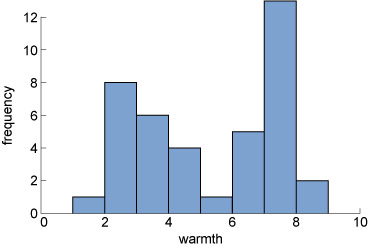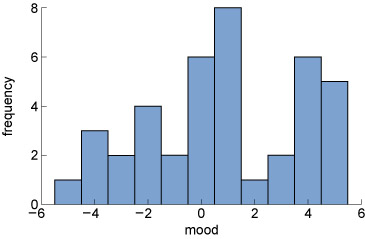2.2 Probability of different types of weather
One analogy that reflects the idea that climate is a range of different types of weather is:
… weather’s how you choose an outfit, climate’s how you choose your wardrobe.
For example, if you live in the UK you might mostly own clothes that provide quite good insulation. But you might also have clothes suitable for hot summers and holidays abroad. Your wardrobe reflects what you expect the range of weather types to be, and how often they will occur. For example, if you example if you expect it to be hot every day you may choose to buy some shorts, but if it is hot for only one day, would that be worth it? This range of clothing warmth could be represented in a histogram (Figure 2).

A similar analogy is:
Weather is like your mood. Climate is like your personality.
Just as for clothing, one could also present a record of one’s moods as a histogram (Figure 3).

In fact, these two analogies hint at a subtlety that is surprisingly important in defining climate and how we study it.
The second analogy – ‘climate is like your personality’ – implies that climate is a kind of history of past weather. What fraction of time during the last week were you in a good, neutral or bad mood? How many hurricanes of different strengths hit Florida during the last decade? This is exactly like the histogram examples shown in Figure 3.
But the first analogy – ‘climate’s how you choose your wardrobe’ – implies that climate is a kind of prediction about future weather. How likely is it to rain today? Perhaps an 80% chance, looking at those slate-grey skies. What proportion of next summer’s days do you predict will be cloudy?
Both are statements about how likely something is; in other words, statements of probability. So, we can also think of climate not only as a summary of what has happened, but as ‘the probability of different types of weather’.
But the difference between them reveals that there are actually two meanings of the word probability:
- The relative frequency of something happening.
- A statement of belief or a prediction about the likelihood of something happening.
Climate scientists use both meanings. They make measurements (of frequencies) to study past climate, to estimate the probability of different types of weather in the past. This is like the definition of ‘the frequency of different types of weather’ that you saw in the previous section. Climate scientists also make predictions (of belief) about future climate: predicting how the probability of different types of weather will change. This meaning is more like an expectation or prediction about the likelihood of different types of weather.
This might – understandably – seem to be getting rather esoteric and obscure. But you will see how these two different ways of thinking about climate matter when we measure and predict climate change.
